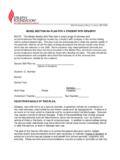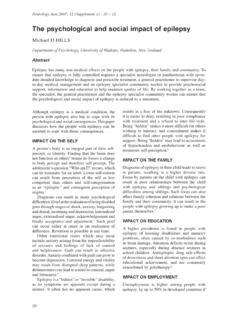Transcription of Living Well with Epilepsy - Centers for Disease Control ...
1 Living *. well Epilepsy II. with R E P O RT OF THE 2003 NATIONAL CONFERENCE. ON PUBLIC HEALTH AND Epilepsy . Priorities for a Public Health Agenda on Epilepsy American Epilepsy Society The Centers for Disease Control and Prevention Chronic Disease Directors Epilepsy Foundation National Association of Epilepsy Centers This publication was supported by Conference Support Grant Number R13/CCR321256-01 from the Centers for Disease Control and Prevention (CDC). Its contents are solely the responsibility of the Epilepsy Foundation and do not necessarily reflect the official views of the CDC, the Department of Health and Human Services, or the federal government. For more information about this report or for additional copies, please contact: Epilepsy FOUNDATION. 4351 Garden City Drive Landover, MD 20785. (800) 332-1000. For more information about specific program activities, please contact: Centers FOR Disease Control AND PREVENTION.
2 National Center for Chronic Disease Prevention and Health Promotion Mail Stop K-40. 4770 Buford Highway NE. Atlanta, GA 30341-3717. (770) 488-5131. AMERICAN Epilepsy SOCIETY. 342 North Main Street West Hartford, CT 06117-2507. (860) 586-7505. NATIONAL ASSOCIATION OF Epilepsy Centers . 5775 Wayzata Boulevard Minneapolis, MN 55416. (612) 525-4526. CHRONIC Disease DIRECTORS. 201 Greensboro Drive, Suite 300. McLean, VA 22102. (703) 610-9033. FROM THE CO-CHAIR. On July 30 and 31, 2003, 200 health professionals, government officials, and consumers gathered to develop a comprehensive public health strategy for Epilepsy . The Living well with Epilepsy II conference, held in Baltimore, Maryland, addressed the many psychosocial and medical aspects of Epilepsy that patients continue to struggle with each day. Significant progress has been made since the first Living well with Epilepsy conference in 1997; education for researchers and consumers has increased, as well as the issuance of specific guidelines for surgery from the American Academy of Neurology.
3 Epilepsy has been addressed by the Agency for Healthcare Research and Quality, and its role in Medicaid contracting has been examined. Most significantly, advances in Epilepsy research have allowed for earlier identification of refractory patients, thus allowing for increased treatment options. There is however, a great deal of work ahead of us. Recommendations outlined in this report will help to shape the public health agenda in regards to Epilepsy . The recommendations address the scope of this much needed work, including the need for early recognition, diagnosis , and treatment;. improved epidemiology and surveillance; advances in self-management; and improved quality of life and impacts and outcomes of Epilepsy . Their clear and focused implementation over the next five years will allow patients to begin to truly live well with Epilepsy . I thank our co-sponsors for their efforts on the Living well with Epilepsy II.
4 Conference: the Centers for Disease Control and Prevention, the American Epilepsy Society, Chronic Disease Directors, and National Association of Epilepsy Centers . I also express a special thank you to my co-chair, Patricia Osborne Shafer, whose leadership in creating this comprehensive report has been invaluable. For those of us on the planning committee, Patty has been the driving force and inspiration that has made all of this possible. Her energy and passion has set the example for all of us. She has been a gentle taskmaster, kindly encouraging everyone to their best efforts. Without her, this conference and this manuscript would never have been completed. This document represents her final official duties as the Chair of the Epilepsy Foundation Professional Advisory Board. To me, it will serve as a fitting work to her distinguished efforts for the past decade on behalf of the Epilepsy Foundation and all people with Epilepsy .
5 Gregory L. Barkley, MD. TABLE OF CONTENTS. I. EXECUTIVE SUMMARY ..4. II. INTRODUCTION ..6. Epilepsy : A Serious, Life-Altering Chronic The Public Health Progress Since the First Living well with Epilepsy Conference ..7. III. Living well with Epilepsy II CONFERENCE ..8. Co-Sponsors and Conference The Charge to Conference IV. REVIEW AND RECOMMENDATIONS ..10. Workgroup A: Early Recognition, diagnosis and Treatment ..10. Charge and Workgroup Speakers ..10. Priority Workgroup B: Epidemiology and Surveillance ..13. Charge and Workgroup Speakers ..13. Priority Workgroup C: Charge and Workgroup Speakers ..17. Priority Workgroup D: Quality of Life Impact and Outcome ..21. Charge and Workgroup Speakers ..21. Priority V. SUMMARY ..26. VI. REFERENCES ..27. VII. APPENDICES ..31. Appendix A: Complete Listing of Recommendations for the Living well with Epilepsy II Appendix B: Activities Resulting from 1997 Living well with Epilepsy Conference.
6 37. Appendix C: Conference Planning Committee, Speakers, and Appendix D: Conference Agendas and Appendix E: Practice Parameters and Resources for Epilepsy I. EXECUTIVE SUMMARY. The public health of our nation is increasingly bur and the character of public health. The need to track the dened by chronic illnesses. Seizures and Epilepsy (also incidence, prevalence, mortality, health status, quality of known as recurring seizures) is one of these chronic disor life, and social outcomes of chronic Disease is now more ders that affects million Americans each year, and many pressing, requiring the public health community to pay more family members, friends, and caregivers regardless of greater attention to these issues, using many of the same age, sex, and ethnicity. with the changing demographics of strategies with which they formerly tracked infection and the United States, the faces of Epilepsy are changing its management.
7 Seizures can begin at any age, yet they occur most common In 1997, the Centers for Disease Control and ly in children and the elderly, with new-onset seizures in Prevention, together with key thought leaders and stake . older Americans fast outpacing any other segment of our holders, began crafting a public health agenda to target key society. Seizures are a common neurological problem that, challenges facing people with Epilepsy . Despite substantial unfortunately, is under-recognized and not treated as signif efforts, the Epilepsy and public health communities have icant by large segments of our society. It is commonly mis recognized a continuing lack of awareness regarding the understood because it is a collection of disorders that have seriousness of Epilepsy and available treatment options different causes, consequences, and outcomes. For many among people with Epilepsy , health care professionals, and people, Epilepsy can be a self-limiting or easily controlled the general public.
8 Delays and discrepancies in how epilep . health problem, but for many more, Epilepsy can be a life sy and its consequences are manifested, diagnosed and long disorder requiring ongoing treatment and enormous treated persist, and are complicated by the social and cul . resources to manage, cope with , and hopefully prevent, tural complexities of our society. These issues led to the many disabling physical, social, cognitive, and emotional need to re-examine critical issues associated with Epilepsy burdens. and how the public health community can respond most Unfortunately, major deficiencies in our national effectively to them. approach to managing Epilepsy are present, including the Living well with Epilepsy II, a national conference on lack of an agreed upon protocol for aggressive Control . public health and Epilepsy , was held in July 2003, and Many people accept lack of seizure Control as inevitable, brought invited experts from the medical, public health, and physicians too often subscribe to a similar philosophy.
9 Academic, advocacy, voluntary health, and corporate com . Consequently, people may never be referred to specialists munities together with people with Epilepsy and their fami . or, when they are, many years of uncontrolled seizures may lies. The goal of the conference was clear review progress have already occurred. Although logic dictates that better, since the first Living well with Epilepsy conference, recom . earlier care will result in better outcomes, research is needed mend needs and priorities for a public health agenda on to substantiate this hypothesis. Efforts to interrupt, prevent Epilepsy for the next five years, and identify other chal . and change the development of Epilepsy must be made with lenges that must be addressed by the Epilepsy community earlier, more aggressive, and systematic care. We must have and those who support it. Participants were assigned to systems and models of care that work better for people with explore one of four areas Early Recognition, diagnosis , Epilepsy and allow people access to this care people in and Treatment; Epidemiology and Surveillance; Self- rural America must have the same expectations and out Management; and Quality of Life Impact and Outcomes comes as those in urban America.
10 Since Epilepsy affects so and asked to address the following tasks: many aspects of life, we must also assure that people obtain the necessary non-medical services needed to combat these To review recent progress in the understanding of problems. seizures and Epilepsy . Seizures and Epilepsy , however, have only been recog . nized by the Centers for Disease Control and Prevention as To identify critical gaps in the scientific basis for a public health concern for the past 10 years, and, although effective recognition, treatment, and prevention of Epilepsy is clearly a chronic Disease with both medical and Epilepsy and its co-morbidities, including effects on social components, it has not been a public health priority. cognition and mood. This was partly because public health has traditionally focused on tracking sources of infectious Disease and related To recommend policies and strategies for removing health hazards with a view to controlling and preventing barriers to optimal health and functioning for per.















